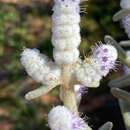pt-BR
nomes no trilho de navegação


Lachnostachys (common name Lambs tails)[5] is a genus of flowering plants in the mint family, Lamiaceae, first described in 1842 by William Jackson Hooker.[1][2] The type species is Lachnostachys ferruginea.[2] The genus name, Lachnostachys, comes from two Greek words/roots, lachnề ("wool") and -stachys ("relating to a spike"),[6] and thus describes the genus as having spiked woolly inflorescences. The entire genus is endemic to Western Australia[4]
A 2009 study of Chloantheae[3] indicates that Lachnostachys is closely related to the genera, Newcastelia and Physopsis, with none of the three being monophyletic.
Plants in this genus are shrubs or subshrub growing from 0.3 to 1.5 m high. They have no essential oils. The young stems are cylindrical and are covered in a dense and thick woolly covering of branched woolly intertwined hairs. The leaves are opposite and decussate (i.e., with successive opposite pairs at right angles to the preceding pair). The leaf blades are entire, or recurved along the margins, or sometimes flat. They are pinnately veined. They are woolly both abaxially and adaxially, although mature leaf blades are sometimes rugose (wrinkled) and glabrescent (becoming hairless). The leaves have both simple and complex hairs (which are stellate).[5]
Lachnostachys (common name Lambs tails) is a genus of flowering plants in the mint family, Lamiaceae, first described in 1842 by William Jackson Hooker. The type species is Lachnostachys ferruginea. The genus name, Lachnostachys, comes from two Greek words/roots, lachnề ("wool") and -stachys ("relating to a spike"), and thus describes the genus as having spiked woolly inflorescences. The entire genus is endemic to Western Australia
A 2009 study of Chloantheae indicates that Lachnostachys is closely related to the genera, Newcastelia and Physopsis, with none of the three being monophyletic.
Lachnostachys es un género de plantas con flores de la familia Lamiaceae con 6 especies aceptadas de las 14 descritas.[2]Es nativo y estrictamente endémico de Australia, esencialmente en el Estado de Western Australia y, además, unos contados puntos dispersos en la isla.[3]
Se trata de arbustos de hasta 1,5m de altura, siempreverdes, con ramitas cilíndricales y cubiertos de un denso y intricado indumento lanudo de pelos dendroides. Las hojas, sin estípulas y también lanudas, son opuestas, sésiles, decusadas y decurrentes o no, de bordes enrollados o, menos habitualmente, enteros. Las inflorescencias son tirsos frecuentemente con hojas -entonces aparentemente axilares- , ramificadas o no, pedunculadas, alargadas en forma de espiga, o más o menos laxas, corimbosas o piramidal-paniculadas, compuestas de numerosas flores bibracteoladas, más o menos actinomorfas, sésiles o subsésiles. Dichas flores tienen el cáliz con 5-9 lóbulos, exteriormente densamente lanudo, mientras la corola, más o menos igual de largo que el cáliz, es de color purpúreo, sin lóbulos o con 5-8 inconspicuos, y de tubo campanulado interiormente peludo. El androceo está constituido por 5-8 estambres, raramente más, exertos y implantados en el borde del tubo de la corola. El gineceo tiene el ovario más o menos lobado con el estilo de estigma entero o diminutamente bífido. El fruto es un núcula tetralocular seca, globosa, indehiscente y con una única semilla.[4][5][6][7]
El género ha sido establecido por William Jackson Hooker y descrito en Icones plantarum or figures, with brief descriptive characters and remarks, of new or rare plants, selected from the author's herbarium, vol. 5, Tab. CDXIV, 1842.[8] Especie tipo: Lachnostachys albicans Hook.
Lachnostachys es un género de plantas con flores de la familia Lamiaceae con 6 especies aceptadas de las 14 descritas.Es nativo y estrictamente endémico de Australia, esencialmente en el Estado de Western Australia y, además, unos contados puntos dispersos en la isla.
Lachnostachys é um gênero botânico da família Lamiaceae
Lachnostachys walcottii
Lachnostachys W.J. Hooker, 1841
Lachnostachys là một chi thực vật có hoa trong họ Hoa môi (Lamiaceae).[1]
Chi Lachnostachys gồm các loài:
Lachnostachys là một chi thực vật có hoa trong họ Hoa môi (Lamiaceae).